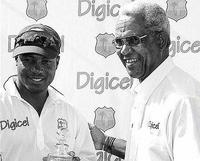
Cricketing legend Sobers (right) with West Indian captain Brian Lara. BASSETERRE, St. Kitts (Reuters):
Wearing the years with the dignity and presence of an old blues musician, Sir Garfield Sobers relived the past for the benefit of an appreciative modern audience during a fleeting visit to St. Kitts last week.
Unlike a musician, writer or painter, the active life of an athlete is fleeting and memories are short.
Fortunately, some of Sobers' greatest moments have been captured on film, he has been lavishly praised in the written word and the statistics endure for ever.
Those who know little else about cricket or Sobers remember he hit six sixes in an over playing for Nottinghamshire back in 1968.
A younger generation were informed that only Sobers and Indian Ravi Shastri had previously managed the maximum number of sixes in an over when South Africa's Herschelle Gibbs struck Daan van Bunge over the boundary six times during a World Cup group match against the Netherlands last week.
LEARNED FROM LISTENING
Sobers, the greatest all-round cricketer in history and one of Wisden Almanac's five cricketers of the 20th century, was flown from Barbados to Basseterre for a ceremony in which he and Gibbs presented a sponsor's cheque for $1 million to charity.
"I had always learned from listening to the older players," Sobers told a news conference. "I remembered Everton Weekes, now Sir Everton Weekes, and Lord (Learie) Constantine telling about the way they played the game of cricket and there were two versions of how to play.
"Everton would always say to keep the ball on the ground. In that way, no one could catch you. Lord Constantine, on the other hand, said if you need to get quick runs, hit in the air.
"There's nobody there to stop it. But you must make sure you clear the boundary. So I took Lord Constantine's version and luckily it came off ... wherever the last ball was pitched it was going to go for six."
FINE MENTOR
Constantine was a fine mentor his Test record is modest, he was a truly great all-round cricketer who played with the concentrated passion and Caribbean flair for which the unexpected Sobers was to demonstrate too with such effect.
There is no quibbling about Sobers's figures. He scored over 8,000 runs at an average only a fraction below 58 with his highest score a then test world record of 365 not out.
He captured 235 wickets, starting his career as an orthodox left-arm spinner, adding wrist spin to his repertoire on the somnolent Indian subcontinent pitches and lively swing bowling elsewhere.
He also led West Indies to series victories over Australia and England in the mid-1960s.
Such skills these days would make Sobers a wealthy man. Instead he was the prototype of the modern international cricketer, playing year round in Australia, England, at home and on tour, the monetary rewards were not there.
"In the '70s and before that, the West Indies played the game because they loved it," he said.
"There was no kind of monetary fund really involved. It was sheer love and enjoyment playing the game. When I went to England in 1957, I used to get five pounds a week.
"The beauty of it was that we were representing our country, the incentive in those days was travelling, to travel to places like Australia, New Zealand, England and Pakistan and those places that you wouldn't have seen otherwise.
"So it was quite different and one could understand the different approach today, there's a lot of responsibility and people expect so much more these days."
WILLOW WAND
Sobers flourished a bat which was little more than a willow wand compared to the bludgeons wielded by Gibbs and his contemporaries. He still hit the ball ferociously hard from a high backlift.
From a short loose-limbed approach and a long sweep of the arm, he bowled wickedly late inswing at a pace which could be genuinely quick.
A swift, agile outfielder as a young man, he became one of the great short-leg fielders to the bowling of spinner Lance Gibbs. His bearing and distinctive rolling gait radiated confidence.
"The walk?" he said. "It wasn't just something that was put on by me over the years playing cricket. It was just a natural walk and a lot of people copied it."
Recently, International Cricket Council Chief Executive Malcolm Speed said the West Indies team from the 1960s to the mid-1990s was the greatest phenomenon in 20th-century team sport.
"The roots of rapid run-getting are clearly in the flamboyance of the West Indies players," he said at the annual Sonny Ramadhin lecture in Trinidad. "They reinvented the game through their style of play with the ball as well as with the bat. The West Indies side of that era was the team everybody wanted to see."
If West Indies were the definitive cricket team, Sobers was the definitive West Indian cricketer.

